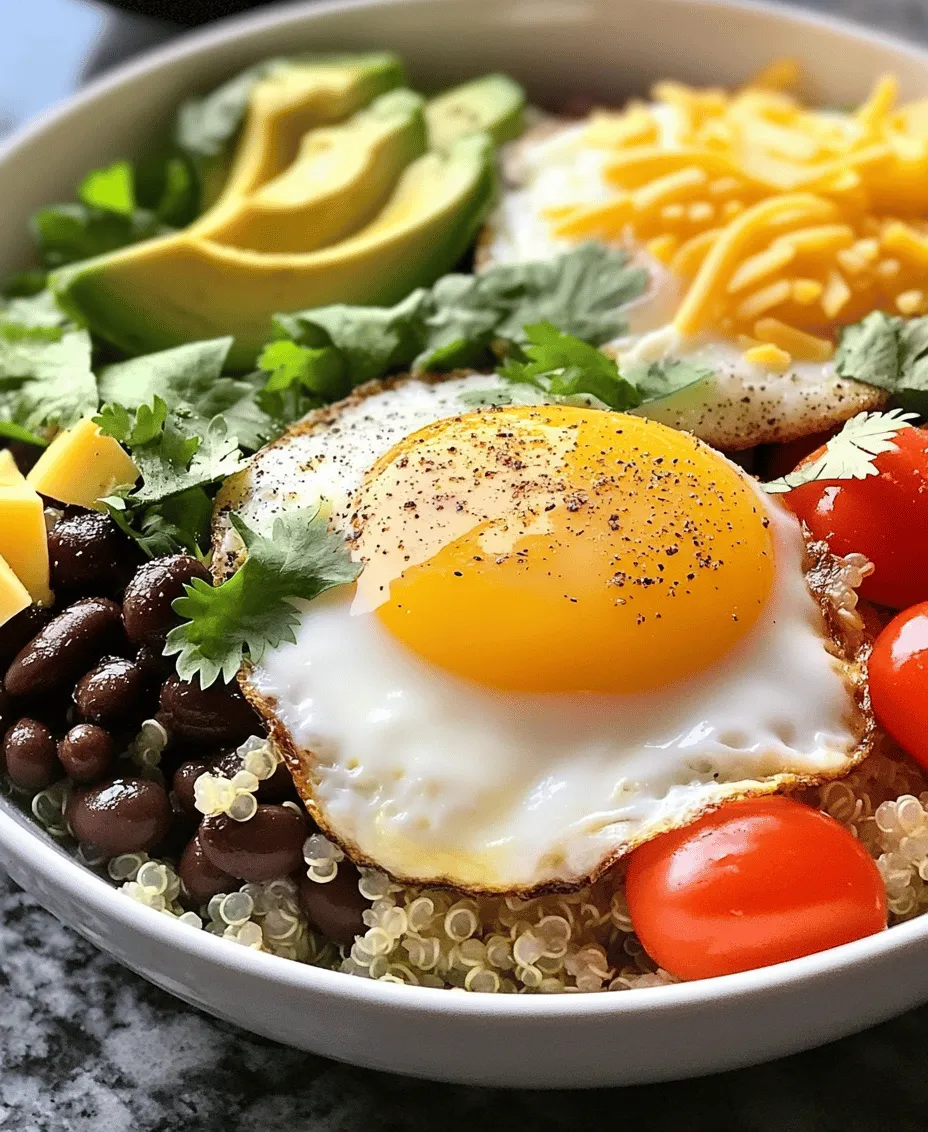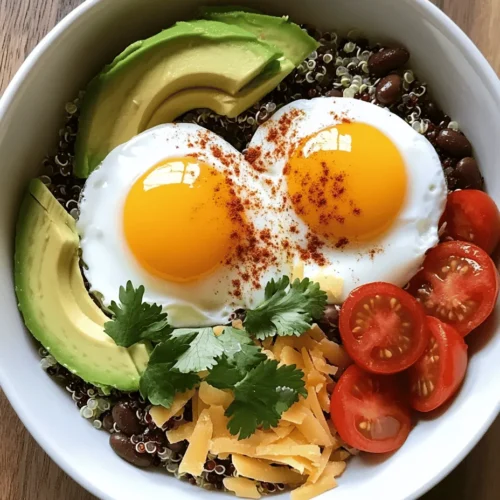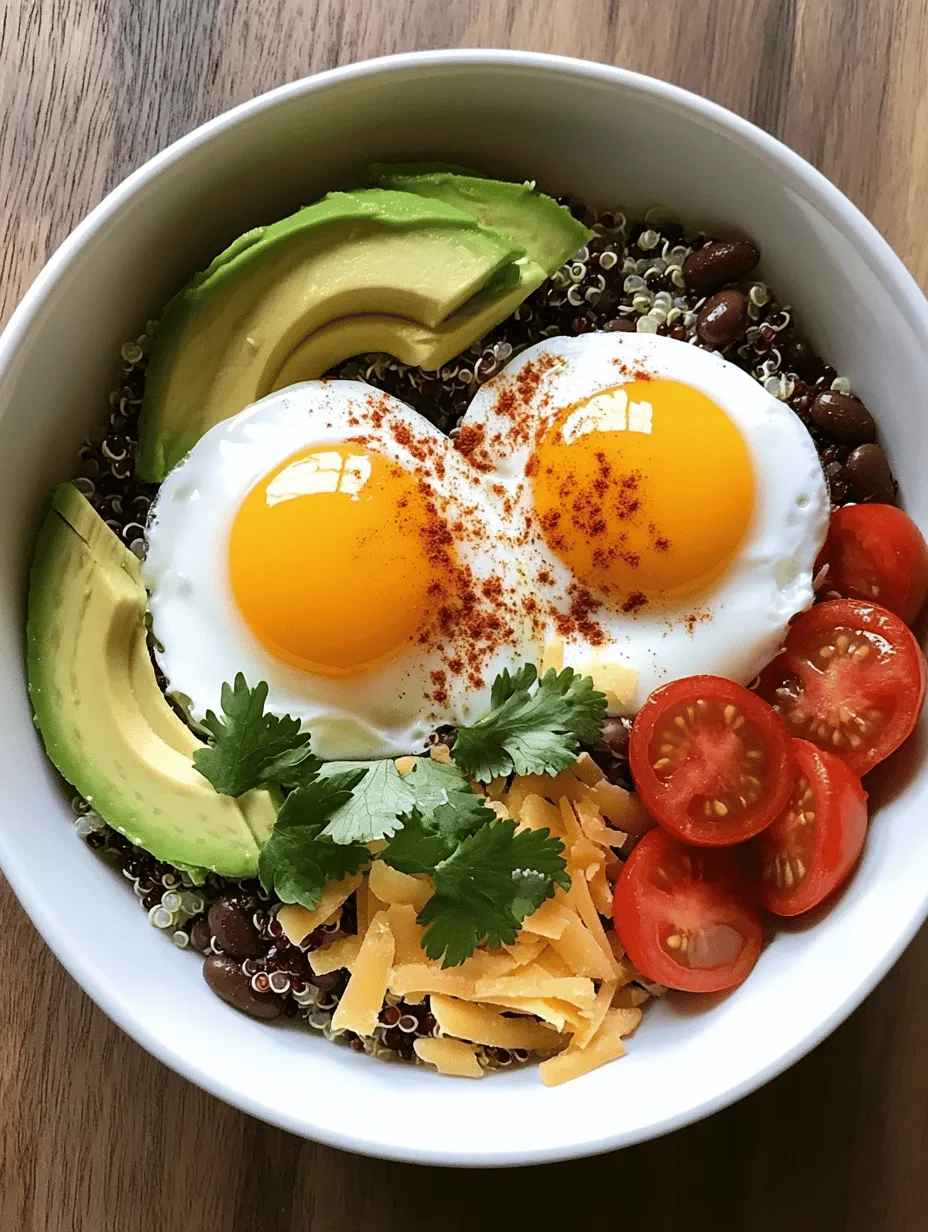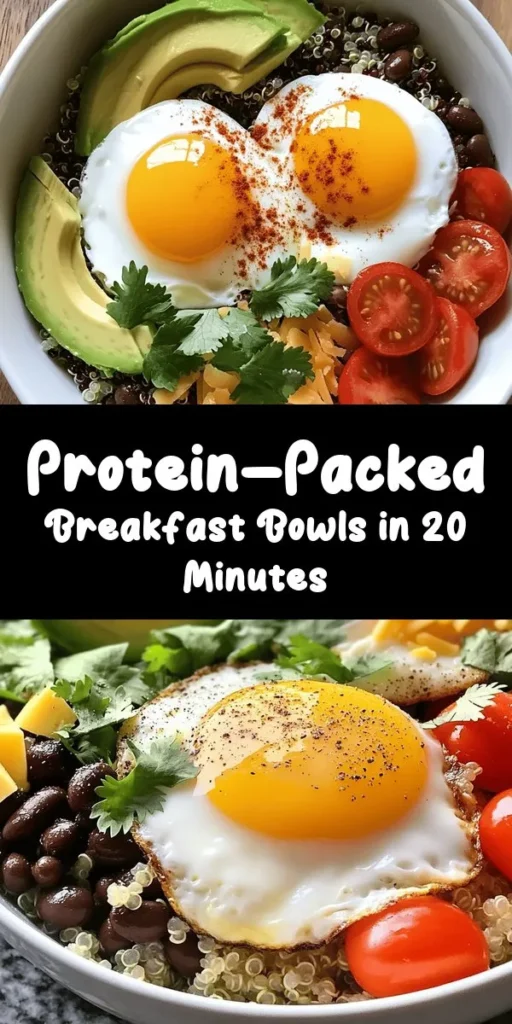Introduction to High-Protein Breakfast Bowls
In today’s fast-paced world, breakfast often takes a back seat as people rush out the door, prioritizing convenience over nutritional value. However, skipping breakfast can lead to decreased productivity and energy levels throughout the day. This is why high-protein breakfast bowls have surged in popularity—they present a perfect solution for individuals seeking a quick yet nutritious meal to kickstart their day. Packed with essential nutrients, these breakfast bowls not only satisfy hunger but also set a positive tone for your dietary choices throughout the day.
This article will guide you through creating an easy, delicious, and nutritious high-protein breakfast bowl that is quick to prepare and bursting with flavor. Whether you are a busy professional, a student, or a parent on the go, this recipe offers a satisfying and health-conscious option that can be tailored to fit your unique taste preferences. Let’s explore the wholesome ingredients that come together to create a delightful meal that caters to your taste buds while supporting your health goals.
Understanding the Importance of Protein in Breakfast
Nutritional Benefits of Protein
Protein is one of the three macronutrients essential for human health, alongside carbohydrates and fats. It plays a vital role in building and repairing tissues, producing enzymes and hormones, and supporting overall bodily functions. When it comes to breakfast, incorporating protein can significantly impact your energy levels and appetite regulation throughout the day. High-protein meals help to keep you fuller for longer, reducing the likelihood of unhealthy snacking later on.
Role of Protein in Energy and Muscle Repair
For those leading an active lifestyle or engaging in regular exercise, protein becomes even more crucial. It aids in muscle repair and growth, making it essential for recovery after workouts. Consuming protein in the morning provides your body with the necessary building blocks to recover and rebuild. Additionally, protein foods have a higher thermic effect, meaning that your body burns more calories digesting them compared to fats and carbohydrates. This can help in managing weight and supporting metabolic health.
High-Protein Breakfast Options Compared to Traditional Breakfasts
Traditional breakfast options, like sugary cereals or pastries, often lack the protein content needed to sustain energy levels. In contrast, high-protein breakfast bowls are versatile and can include a variety of protein sources, ensuring a nutrient-dense start to the day. Options like eggs, Greek yogurt, and legumes can easily be integrated into your breakfast routine, providing a powerful combination of protein and other vital nutrients that traditional breakfasts often overlook.
Overview of Easy High-Protein Breakfast Bowls
What Makes This Recipe Stand Out
What sets this high-protein breakfast bowl apart from others is its ease of preparation and the flexibility it offers. You can create a satisfying meal in under 30 minutes, using ingredients that are not only nutritious but also readily available. This recipe is designed to accommodate various dietary preferences, including vegetarian and gluten-free options, making it a versatile addition to anyone’s breakfast repertoire.
Key Ingredients and Their Health Benefits
The ingredients used in these high-protein breakfast bowls are not just about protein; they also contribute a spectrum of vitamins, minerals, and healthy fats. From the wholesome grains that serve as a base to the vibrant vegetables that add flavor and nutrition, each component plays a critical role in making this meal both nourishing and tasty.
Flexibility in Ingredients for Personal Preferences
One of the standout features of this recipe is its adaptability. You can customize your high-protein breakfast bowl according to your dietary preferences and what you have on hand. Whether you prefer quinoa, brown rice, or even a plant-based protein source, this recipe can cater to both traditional and modern dietary choices. The ability to mix and match ingredients means you can keep your breakfast exciting and fresh each day.
Ingredients Breakdown for High-Protein Breakfast Bowls
Cooked Quinoa or Brown Rice: A Nutritious Base
For a hearty base, cooked quinoa or brown rice forms the foundation of this breakfast bowl. Quinoa is a complete protein, meaning it contains all nine essential amino acids, making it an excellent choice for those looking to increase their protein intake. Brown rice, on the other hand, is a whole grain packed with fiber, which aids digestion and keeps you feeling full longer. Both options are gluten-free and can be prepared in advance, allowing for quick assembly during busy mornings.
The Power of Eggs: Versatility and Protein Source
Eggs are often hailed as one of the best sources of protein available. A single large egg contains about 6 grams of protein, along with essential vitamins and minerals like vitamin B12 and selenium. They are incredibly versatile and can be prepared in numerous ways—boiled, scrambled, or poached—making them a perfect addition to your breakfast bowl. Their creamy texture complements the other ingredients beautifully, enhancing the overall flavor and satisfaction of the meal.
Canned Black Beans: A Convenient and Healthy Addition
Canned black beans are a fantastic source of plant-based protein and dietary fiber. They are not only convenient but also rich in antioxidants and nutrients such as iron and magnesium. Adding black beans to your breakfast bowl boosts its protein content and provides a satisfying texture. They can be mixed in or served on top, adding a heartiness that pairs well with the other fresh ingredients.
Avocado: The Creamy Superfood
Avocado has gained a reputation as a superfood for good reason. Packed with healthy monounsaturated fats, fiber, and an array of vitamins, avocados contribute to heart health and satiety. Their creamy texture adds a delightful contrast to the other ingredients, making them a must-have in any high-protein breakfast bowl. Slice or mash avocado and layer it on top for an indulgent yet healthful addition.
Cherry Tomatoes: Burst of Flavor and Nutrition
Cherry tomatoes bring a burst of flavor and color to your breakfast bowl, elevating its aesthetic appeal. They are an excellent source of vitamins A and C, as well as antioxidants like lycopene, which have been linked to various health benefits. Whether you choose to roast them for added sweetness or leave them fresh for a crisp bite, cherry tomatoes add vibrancy and nutrition to your morning meal.
Greek Yogurt: Creaminess Packed with Protein
Greek yogurt is another powerhouse ingredient that enhances the protein content of your breakfast bowl. With nearly double the protein content of regular yogurt, Greek yogurt is a creamy addition that can be used as a base or a topping. It also provides probiotics that promote gut health. Whether you enjoy it plain or flavored, incorporating Greek yogurt will not only boost the protein content but also add a luscious creaminess to your dish.
Shredded Cheese: Adding Flavor and Texture
For those who enjoy cheese, a sprinkle of shredded cheese can bring an extra layer of flavor to your high-protein breakfast bowl. Cheese provides additional protein, calcium, and a savory taste that complements the other ingredients. Choose a cheese variety that suits your palate—cheddar, feta, or a dairy-free option—and enjoy the delightful combination of flavors.
Olive Oil and Spices: Enhancing Flavor Profiles
Drizzling your breakfast bowl with a high-quality olive oil adds richness and enhances the flavor profile of the dish. Olive oil is known for its heart-healthy properties and can elevate the overall taste experience. Additionally, don’t shy away from seasoning your bowl with spices like cumin, paprika, or black pepper to add depth and a kick to each bite. Experimenting with different herbs and spices can transform your breakfast bowl into a culinary delight.
Garnishing Options: Elevating Presentation and Taste
To elevate your breakfast bowl further, consider adding garnishing options such as fresh herbs, seeds, or nuts. Chopped cilantro or parsley can add freshness, while seeds like pumpkin or sunflower contribute a delightful crunch and additional nutrients. A sprinkle of nuts, such as almonds or walnuts, can enhance the texture and provide healthy fats, making your breakfast bowl not just a meal but a feast for the senses.
Step-by-Step Instructions for Preparation
Preparing your high-protein breakfast bowl is an uncomplicated process that can be done in a few simple steps. Here’s how to get started:
1. Prepare Your Base: Begin by cooking your quinoa or brown rice according to package instructions. If you’re using leftovers, simply reheat them in the microwave or on the stovetop.
2. Cook the Eggs: While your base is cooking, prepare your eggs. You can choose to scramble, boil, or poach them based on your preference. For scrambled eggs, whisk them in a bowl, season with salt and pepper, and cook in a non-stick skillet until fluffy. If boiling, place eggs in a pot of water, bring to a boil, then simmer for about 6-8 minutes for a soft yolk.
3. Warm the Black Beans: If using canned black beans, rinse them under cold water and then heat them in a small saucepan over medium heat until warmed through. This step is quick and ensures that they are ready to be added to your bowl.
4. Prepare the Vegetables: Slice your cherry tomatoes and avocado. If you like, you can also sauté the cherry tomatoes in a little olive oil for a few minutes to enhance their sweetness.
5. Assemble the Bowl: Once all your components are ready, it’s time to assemble your breakfast bowl. Start by placing your base of quinoa or brown rice at the bottom. Layer on the warmed black beans, cooked eggs, sliced avocado, and cherry tomatoes.
6. Add Toppings: Finish off your bowl with a generous dollop of Greek yogurt, a sprinkle of shredded cheese, and a drizzle of olive oil. Season with your choice of spices and add any garnishes you prefer.
7. Enjoy: Your easy high-protein breakfast bowl is now ready to be enjoyed! Dig in and relish the combination of flavors and textures while fueling your body for the day ahead.
By following these straightforward steps, you can create a nutritious and satisfying breakfast bowl that delivers on both taste and health benefits. In the following sections, we will delve deeper into additional tips for perfecting your high-protein breakfast bowl and answer common questions to help you make the most out of this delightful meal.

Preparing the Base: Quinoa or Brown Rice
The foundation of any great breakfast bowl starts with a wholesome grain. For this high-protein breakfast bowl, you can choose between quinoa and brown rice, both of which offer unique textures and flavors.
Quinoa is a complete protein, meaning it contains all nine essential amino acids, making it an excellent choice for breakfast. It cooks quickly, usually in about 15 minutes, and has a fluffy texture that pairs well with various ingredients. To prepare quinoa, rinse 1 cup under cold water to remove its natural coating, called saponin, which can give a bitter taste. Combine it with 2 cups of water or broth in a pot, bring to a boil, reduce heat, cover, and simmer for about 15 minutes or until the liquid is absorbed. Fluff with a fork and set aside.
Brown rice, on the other hand, is a heartier grain that provides a nutty flavor and chewy texture. It takes longer to cook—about 40-45 minutes—but is rich in fiber and other essential nutrients. To cook brown rice, rinse 1 cup under cold water, then combine it with 2.5 cups of water in a pot. Bring to a boil, reduce heat, cover, and simmer for 40-45 minutes. Once cooked, let it sit for 10 minutes before fluffing with a fork. Both grains can be prepared in advance and stored in the fridge for easy assembly later.
Cooking the Eggs: Techniques for Desired Doneness
Eggs are a stellar source of protein and healthy fats, making them a perfect addition to any breakfast bowl. Depending on your preference, you can cook your eggs in several ways. Here are a few techniques to achieve the desired doneness:
1. Scrambled Eggs: For fluffy scrambled eggs, whisk 2-3 eggs in a bowl with a pinch of salt and pepper. Heat a non-stick skillet over medium heat and add a pat of butter or a splash of olive oil. Pour in the eggs and let them sit for a few seconds before stirring gently with a spatula. Cook until just set but still slightly creamy, about 3-4 minutes.
2. Fried Eggs: If you prefer sunny-side up or over-easy eggs, heat a non-stick skillet over medium heat and add a little oil or butter. Crack the eggs into the pan and cook until the whites are set but the yolks remain runny, about 2-3 minutes. For over-easy, gently flip the eggs and cook for an additional minute.
3. Poached Eggs: Poaching eggs creates a deliciously runny yolk that beautifully complements the other ingredients. Bring a pot of water to a gentle simmer and add a splash of vinegar. Crack an egg into a small bowl, then gently slide it into the water. Cook for about 3-4 minutes until the whites are set and the yolk is still runny. Remove with a slotted spoon and let drain.
Choose your preferred egg style and prepare them just before assembling your breakfast bowl to ensure they are warm and fresh.
Layering the Beans and Vegetables: Building Flavor
Now that your base and eggs are ready, it’s time to layer in the beans and vegetables. Beans are a fantastic source of plant-based protein and fiber, which will keep you feeling full longer. Black beans, kidney beans, or pinto beans work well in breakfast bowls.
1. Beans: If using canned beans, drain and rinse them under cold water to reduce sodium content. Heat them in a small saucepan over medium heat until warmed through, about 5 minutes. Season with a pinch of cumin or chili powder for extra flavor.
2. Vegetables: Fresh vegetables add color, flavor, and nutrients to your bowl. Consider using bell peppers, spinach, tomatoes, or avocado. For a warm element, sauté diced bell peppers and chopped onions in a skillet with a bit of olive oil until soft, about 5-7 minutes. Fresh spinach can be wilted in the same pan for just a minute or two.
Building your bowl in layers not only enhances flavor but also makes it visually appealing. Start with a generous serving of quinoa or brown rice, followed by a scoop of beans, sautéed vegetables, and finally, top it off with your eggs.
Assembling the Bowl: Creating a Visual Delight
Now comes the fun part—assembling your high-protein breakfast bowl! Start by placing your chosen base (quinoa or brown rice) in the bottom of a bowl. Ensure it’s a good portion, filling about half of the bowl to create a solid foundation.
Next, layer the warmed beans on one side of the bowl and the sautéed vegetables on the other. This not only creates visual appeal but allows for a beautiful contrast of colors. Add your cooked eggs on top, whether you scrambled, fried, or poached them.
To enhance the visual delight further, consider adding a handful of fresh greens, such as arugula or microgreens, on one side of the bowl. This will add a pop of color and freshness to your meal.
Garnishing for Flavor and Presentation
Garnishing elevates your breakfast bowl, enhancing both flavor and presentation. Here are a few ideas for delicious and nutritious garnishes:
– Avocado: Sliced or diced avocado adds creaminess and healthy fats. It can be placed on the side of the bowl or on top of the eggs.
– Fresh Herbs: Chopped cilantro, parsley, or chives can freshen up your dish. Sprinkle them over the top for added flavor.
– Hot Sauce or Salsa: A drizzle of your favorite hot sauce or a spoonful of salsa can add a zesty kick and complement the flavors beautifully.
– Seeds or Nuts: For a crunch, sprinkle some pumpkin seeds or chopped nuts over the top. They add an extra layer of texture and nutrition.
Taking the time to garnish your bowl not only enhances its appearance but also contributes to the overall flavor experience.
Nutritional Analysis of the High-Protein Breakfast Bowl
Understanding the nutritional composition of your high-protein breakfast bowl is essential for maintaining a balanced diet and achieving your health goals.
Caloric Breakdown of Ingredients
A typical high-protein breakfast bowl, comprising quinoa, eggs, beans, and vegetables, generally contains around 400-600 calories, depending on portion sizes and additional ingredients. Here’s a rough breakdown:
– Quinoa (1 cup cooked): 222 calories
– Eggs (2 large): 140 calories
– Black beans (1/2 cup): 114 calories
– Sautéed vegetables (1/2 cup): 50 calories
– Avocado (1/4 medium): 80 calories
This totals approximately 606 calories, which can be adjusted based on your preferences or dietary needs.
Protein Content and Its Impact on Daily Intake
Protein is crucial for maintaining muscle mass, repairing tissues, and keeping you satiated. This breakfast bowl offers a significant protein boost, with the following approximate protein content:
– Quinoa: 8 grams
– Eggs: 12 grams
– Black beans: 7 grams
In total, this bowl provides around 27 grams of protein, which is excellent for a breakfast meal. This amount can significantly contribute to the recommended daily intake, which varies based on activity level, but generally falls between 46-56 grams for adults.
Vitamins and Minerals in Each Ingredient
Each component of the breakfast bowl contributes various vitamins and minerals:
– Quinoa: High in magnesium, iron, and B vitamins.
– Eggs: A good source of vitamin D, B12, and selenium.
– Black beans: Rich in fiber, potassium, and folate.
– Vegetables: A variety of vitamins depending on the choice, including vitamin C from bell peppers and iron from spinach.
This combination not only provides a hefty dose of protein but also ensures you’re getting a well-rounded meal filled with essential nutrients.
Comparative Analysis of Protein Bowls with Other Breakfasts
When compared to traditional breakfast options like pancakes, sugary cereals, or baked goods, high-protein breakfast bowls stand out in terms of nutritional value. Many conventional breakfast items can be high in simple carbohydrates and sugars, leading to quick spikes in blood sugar levels. In contrast, a high-protein breakfast bowl offers a balance of protein, fiber, and healthy fats, keeping you satiated for longer and providing sustained energy throughout the morning.
Customization and Variations of High-Protein Breakfast Bowls
One of the best aspects of high-protein breakfast bowls is their versatility. You can easily customize them to fit your dietary preferences and seasonal availability.
Incorporating Different Proteins: Tofu, Chicken, or Turkey
If you’re looking to switch up your protein source, consider using:
– Tofu: A great option for vegetarians and vegans, tofu can be scrambled or cubed and sautéed for added flavor.
– Grilled Chicken: For those wanting a heartier option, grilled chicken breast can be sliced and added to the bowl.
– Ground Turkey: Seasoned ground turkey can be cooked quickly and adds a savory flavor profile.
Vegetarian and Vegan Options: Plant-Based Protein Sources
Vegetarians and vegans can easily adapt the recipe by focusing on plant-based proteins. In addition to tofu, consider:
– Lentils: Cooked lentils are nutrient-dense and can add a different texture to your bowl.
– Chickpeas: Roasted or sautéed chickpeas add protein and a satisfying crunch.
– Edamame: These young soybeans can be tossed in for a protein boost and vibrant color.
Changing Up the Grains: Alternatives to Quinoa and Rice
While quinoa and brown rice are fantastic bases, feel free to experiment with other grains:
– Farro: Offers a chewy texture and nutty flavor.
– Barley: A great source of fiber and has a distinct taste.
– Millet: A gluten-free grain that cooks quickly and has a mild flavor.
Seasonal Ingredients: Adjusting to What’s Fresh
Incorporating seasonal vegetables not only enhances flavor but also boosts nutrient content. In the spring, consider using asparagus or peas; in the summer, zucchini and tomatoes are excellent choices; fall might call for roasted sweet potatoes or butternut squash; and winter can feature hearty greens like kale or collards.
Storage and Meal Prep Tips for Breakfast Bowls
Preparing high-protein breakfast bowls in advance can save time during busy mornings. Here are some tips for effective meal prep and storage.
Preparing in Advance: Batch Cooking for Convenience
Cook larger batches of quinoa or brown rice at the beginning of the week and store them in the fridge. Similarly, prepare a batch of beans or lentils in advance. Also, consider pre-chopping vegetables and storing them in airtight containers for quick assembly.
Storage Solutions: Keeping Ingredients Fresh
To maintain the freshness of your ingredients, use airtight containers to store cooked grains, beans, and chopped vegetables in the refrigerator. Cooked eggs can be stored in the fridge for up to one week. To keep avocado fresh, you can store it with the pit in or sprinkle lemon juice on it to prevent browning.
Reheating Guidelines: Maintaining Flavor and Texture
When reheating your breakfast bowl, do so gently in the microwave or on the stovetop. Add a splash of water or broth to the grains and beans to prevent them from drying out. For eggs, reheat them separately to avoid overcooking.
Conclusion: Enjoying Your High-Protein Breakfast Bowls
High-protein breakfast bowls are not only a delicious way to start your day but also a practical solution for those seeking a nutritious, satisfying meal. They can be tailored to suit various dietary needs and preferences, making them an ideal choice for everyone from busy professionals to health-conscious families.
With their vibrant colors, delightful textures, and customizable ingredients, these breakfast bowls offer a nourishing way to fuel your morning and keep your energy levels stable throughout the day. Enjoy the combination of flavors and the satisfaction of knowing you’re nourishing your body with wholesome, high-protein ingredients. Whether you prepare them in advance or whip them up fresh, high-protein breakfast bowls are a delightful addition to any breakfast routine.



